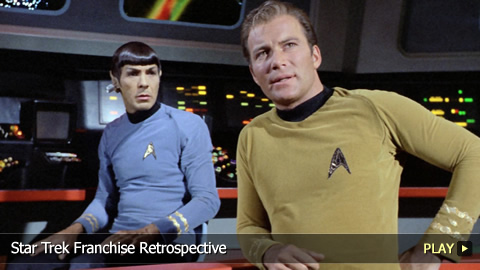Star Trek Franchise Retrospective

advertisement
VOICE OVER: Rebecca Brayton
Introduced to American television audiences on September 8th, 1966, the original Star Trek series was developed by TV producer and scriptwriter Gene Rodenberry. The series showcased spectacular special effects and a utopian view of the future. It also successfully merged thought-provoking science fiction with the more dramatic and thrilling elements of westerns, which were incredibly popular at the time. Despite getting canceled after only three years, the show spawned numerous films, several sequel series, and countless dedicated fans and remains one of the most iconic sci-fi franchises today. Join http://www.WatchMojo.com as we take a look back at the history of Star Trek.
Star Trek Franchise Retrospective
This ground-breaking sci-fi series was originally envisioned as a western in outer space. Welcome to WatchMojo.com and today we’ll be taking a look at the history of Star Trek.
Introduced to American television audiences on September 8th, 1966, the original Star Trek series was developed by TV producer and scriptwriter Gene Rodenberry. The series showcased spectacular special effects and a utopian view of the future. It also successfully merged thought-provoking science fiction with the more dramatic and thrilling elements of westerns, which were incredibly popular at the time. In fact, Star Trek was originally pitched as a “Wagon Train to the Stars.”
The show aired for three seasons before being abruptly cancelled. In that time, the crew of the U.S.S. Enterprise embarked on a five-year mission into the vastness of space “to explore new life and new civilizations, to boldly go where no man has gone before.”
While it didn’t attract a large audience in its original run, it developed a loyal fan-base that gravitated towards the show’s three main characters.
These included the charismatic Captain James T. Kirk as portrayed by William Shatner, his logic-based Vulcan Science Officer Mr. Spock played by Leonard Nimoy, and the irritable Dr. McCoy as depicted by DeForest Kelley.
The show distinguished itself from anything else on the air as the rest of the crew was portrayed as diversely multi-cultural. A few of these characters included the ship’s engineer Montgomery Scott, the communication’s officer Uhura, and the navigation officers Sulu and Checkov.
Star Trek posed a uniquely positive view of the future, with all humans coming together regardless of origin or ethnicity to explore the universe. As such Star Trek was unlike anything that had ever been seen before, and even dared to feature television’s first interracial kiss.
Following the show’s cancellation in 1969, fans banded together to petition for the return of the short-lived franchise. They were successful, and the original series received not just one, but six motion pictures between the years 1979 and 1991.
At the same time, the growing popularity of Star Trek allowed Rodenberry to release a spin-off TV series called “Star Trek: The Next Generation” in 1987.
This show took place 80 years after the events of the original, and featured an entirely new crew. The Next Generation also introduced a much larger starship Enterprise that was filled with a huge federation of officers, civilians and scientists.
This team was led by Patrick Stewart’s rational and more diplomatic Captain Jean-Luc Picard, and consisted of his Canadian first officer William Riker, android science officer Data, blind engineer Geordie LaForge, Klingon security officer Worf, Dr. Beverley Crusher, her son Wesley, and the telepathic counselor Deanna Troi.
Keeping in step with the show’s increased enthusiasm for strong female characters, film star Whoopi Goldberg appeared as the ship’s wise alien bartender Guinan. (guy-nan)
Following the show’s impressive seven year run on TV, it landed in syndication. The crew also embarked on four of their own feature-film adventures, with the first bringing back several characters from the original series to officially pass the torch to the next generation.
Meanwhile, the franchise saw several spin-offs emerge and compete for airtime. These included the space-station-based show “Deep Space Nine,” the lost-in-space formatted “Star Trek: Voyager,” and the unpopular prequel series “Enterprise.”
In an ironic twist of fate, “Enterprise” was cancelled in a similar fashion to the original ‘60s series, and this appeared to signal the end of the franchise. The dwindling audience felt the market had become oversaturated with a never-ending barrage of Star Trek media. Viewers also marked a noticeable dip in the quality of storytelling.
Four years after the cancellation of Enterprise, director J.J. Abrams was brought in to helm an all-new motion picture with a fresh direction and cast of actors. The result was 2009’s wildly popular and unique “Star Trek.” This thrilling franchise reboot centered on the early years of the original Trek crew within an alternate timeline.
An iconic and groundbreaking science fiction franchise, Star Trek remains beloved by its passionate fan base, and continues to tell gripping stories decades after redefining and modernizing the science fiction genre.

